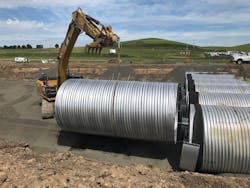Pullman Moscow Regional Airport Runway Realignment – Stormwater Treatment
The Pullman-Moscow Regional Airport (PUW) in Pullman, WA, cut the ribbon on its new $154 million runway in October 2019. The 6,700-foot-long runway was rotated 5.5 degrees and extended 400 feet to 7,100-foot-long length. The realignment and lengthening were done to comply with Federal Aviation Administration (FAA) design standards, improve airport procedures, and reduce winter weather-related flight cancellations.
Reconstruction of existing impervious areas and adding new impervious areas required stormwater flow control and treatment measures to comply with most current Washington State Department of Ecology General Use Level Designation (GULD) standards. The project was reviewed by WADOT, FAA and the City of Pullman.
Engineers utilized underground detention instead of a traditional detention pond to save space and eliminate a pond that would attract wildlife and pose a safety risk to aircraft.
A Contech corrugated metal pipe (CMP) detention system was selected as the preferred solution Vs. a cast-in-place concrete vault based on cost savings. Engineers from Mead and Hunt designed a split detention system made from 2,120LF of 120” and 195LF of 96” solid Aluminized Steel Type 2 (CMP) hydraulically connected with an upturned elbow in the 96” pipe to overflow into the 120” pipe. Pretreatment is provided by two Contech CDS hydrodynamic separators.
The 120” CMP was placed under a parking lot and included a Stormwater Management StormFilter in a manhole configuration to provide water quality treatment. Vortex valves were used to optimize flow control discharge rates across a range of head values. This allowed engineers to reduce the overall detention footprint
15% - 20%. Contech also provided slotted drain to collect pavement runoff where a new taxiway connector met the existing terminal apron pavement.
This design required complex modeling from the engineer, which Contech assisted by providing technical system details and sizing calculations.
The systems were ordered during the winter to allow for fabrication for Spring delivery. Challenging site conditions with wet clay soils made the installation challenging. The Covid pandemic was also a factor, requiring social distancing and the use of face masks.
“Contech staff provided useful information regarding optimal system layout, materials selection, facility sizing, construction expectations, and more from early in the design process all the way through construction,” said Bob Thayne, PE, Water Resources Engineer. “They were responsive, friendly, and helpful at all times.”






